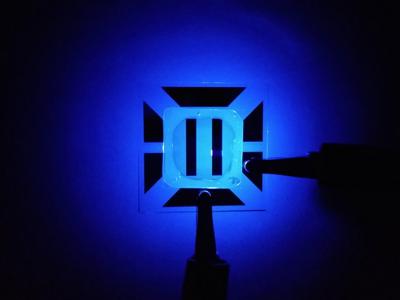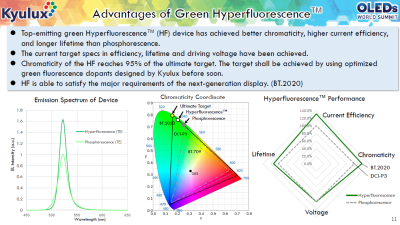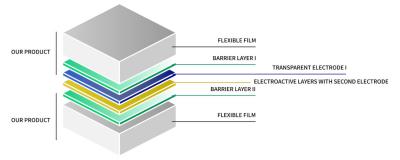OLED displays use organic materials that emit light when electricity is applied. OLEDs enable emissive, bright, thin, flexible and efficient displays. OLEDs are set to replace LCDs in all display applications - from small displays to large TV sets.

UDC OLED material performance, 2012
One of the main problems of OLED displays is the limited lifetime of the OLED materials. In past years we have seen great advances in this area, and today OLED materials are quite long lasting - with material lifetime reaching million hours or more.
Blue OLED lifetime
A blue OLED emitter is the most unstable emitter, and blue OLEDs (required to create a full-color display) suffer from short lifetimes. This is especially true for the efficient phosphorescent blue emitter - and today there's still no commercial efficient blue emitter.
The OLED industry is seeking several routes to develop an efficient blue. PHOLED pioneer Universal Display is developing a blue PHOLED, but has yet to find a commercial-ready material. Other promising route is TADF emitter technology.
The latest OLED lifetime news:
Important things to keep in mind when designing an OLED micro-display project
This is a guest article by Assaf Levy-Be'eri, co-founder at JOYA Team, an optical technologies house offering development services for optical systems with an expertise in AR and VR.
The Augmented Reality (AR) systems field has recently expanded to many different applications and markets. With all the buzz around Metaverse, there is an understanding that AR systems will become the bridge between the real world and the virtual world and will allow the user to combine these worlds.
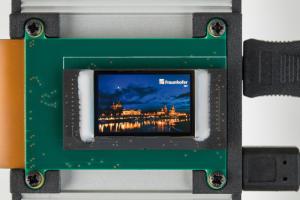
However, the road to a sustainable, affordable AR system that is user-friendly and that provides real-life experience is still a long one.
Universal Display reports record revenues in Q3 2021
Universal Display reported its financial results for Q3 2021. Revenues were a record $143.6 million, up from $117.1 million in Q3 2020 and net profit was $46.1 million (up from $40.5 million from Q3 2020). The company has about $789 million in cash and equivalents, the it reiterates its full-year 2021 revenue guidance to be between $530 million and $560 million.

Regarding its blue PHOLED R&D effort, UDC says it is making "excellent progress", and the company believes that a commercial blue material is a question of when and not if.
LGD is developing a tandem-stack 12.9" LTPO AMOLED display for Apple's 2024 iPads
A few days ago we posted that Apple has reportedly decided to delay its iPad OLED launch to 2023, and the company canceled its current joint development project with Samsung Display, as SDC could not develop what Apple wanted - a tandem stack structure, which would have improved the lifetime and performance of the AMOLED display.
According to a new report from Korea, LG Display is also developing a tablet display for Apple - a 12.9" AMOLED panel. LG's iPad display will be ready for mass production by 2023-2024, and it will use a tandem (2 stacks) architecture on an LTPO backplane. As SDC's project is canceled, it is likely that LG's 12.9" will be the first OLED adopted by Apple's tablets.
Kyulux: our green Hyperfluoresence emitter is getting close to commercialization
Hyperfluoresence emitter system developer Kyulux announced that its green material is getting close to commercialization. The company is now working closely with OLED makers, preparing for early adoption.
Kyulux says that its green emitter has not only met the required performance of OLED panel makers, in terms of efficiency, lifetime and driving voltage - but has actually surpassed the performance of green phosphorescent emitters in top emission devices. The green HF device achieves higher current efficiency, longer lifetime and offers a narrow emission spectrum and can thus enable better chromaticity.
Apple delays its OLED iPad plans to 2023
Reports from Korea suggest that Apple has decided to delay its iPad OLED launch to 2023, and the company canceled its current joint development project with Samsung Display.
SDC aimed to develop a 10.86 AMOLED display for Apple's iPad. According to earlier reports, Apple wanted SDC to developed a tandem stack structure to improve the OLED device lifetime and brightness - and also to reduce burn-in problems. Apparently SDC is not ready to start tandem OLED production next year, and Apple will not accept a single-stack OLED for tablet applications.
Cynora achieves breakthrough in its green TADF material, test kits are now available for display makers
OLED material developer Cynora announced that it achieved a breakthrough in its deep-green TADF material, which it brands as cyUltimateGreen. The new material delivers an efficiency of over 20% (EQE), a lifetime of 400 hours (LT95@15mA) and a color point and emission spectrum that matches today's DICI-P3 standard (Cynora does not specify the exact number).
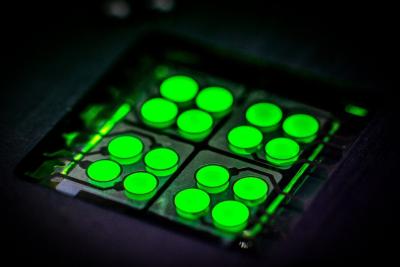
Cynora further announced that is now making test kits of the new deep-green emitter available to its customers. Display makers can now start testing and verification using the new material. Cynora says it will also 'soon' follow with a deep-blue TADF solution.
Ergis launches a new OLED encapsulation film platform
Poland-based Ergis Group has developed a new solution for OLED panel encapsulation. The noDiffusion film, developed in collaboration with Ergis' partners can be adopted as both the flexible substrate and the encapsulation layer for OLED devices.
The Ergis noDiffusion film offers high barrier properties, high level of optical transmittance and a low level of light scattering. This enables the production of OLED displays with extended lifetimes, efficiency and image properties. The noDiffusion film can also be used in the production of solar panels to increase panel efficiency and lifetimes.
Ergis says that the biggest advantage of its new film solution is the lower manufacturing costs, as the films already include an embedded encapsulation layer and could optionally include an embedded electrode layer.
Kyulux updates on its latest Hyperfluorescence TADF emitter performance
Kyulux presented a new paper at SID Displayweek, that shows the latest progress of the company's Hyperfluorescence OLED emitter platform. You can see the latest performance chart below.
Hyperfluorescence combines TADF and fluorescence emitters, which enables high-efficiency (~100% IQE) emitters that feature long lifetimes and a very narrow emission spectrum. The company's yellow HF emitter is already commercialized, and now Kyulux says that its red and green materials are "close to commercialization". The company is also improving the color point and lifetime of its HF blue emitters.
OLEDWorks to introduce a new high-performance multi-stack OLED microdisplay technology
OLED lighting developer OLEDWorks announced that it has developed a high-performance multi-stack OLED microdisplay technology. Next week at SID Displayweek OLEDWorks will present the technology, and results from 3, 4 and 5-stack microdisplay formulations.
OLEDWorks explains that it has realized its multi-stack OLED lighting technology - and the results are "exceptional". The company says that combined wit its unique and cost-effective manufacturing technology, microdisplays based on this new technology could combine high brightness, long lifetimes, exceptional power efficiencies - all at a low manufacturing cost.
Kopin developed a double-stack OLED architecture for higher brightness OLED microdisplays
Kopin Corporation announced that the company developed a new double-stack OLED architecture that enables brighter microdisplays with longer lifetime.
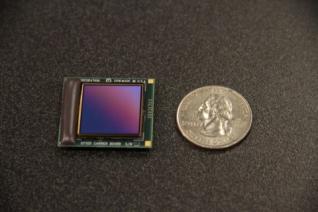
Kopin 1" 2k x 2k OLED Lightning microdisplay
Last week Kopin announced a new 1.3" 2560x2560 OLED microdisplay, and the company now reveals that this display uses the new double-stack architecture and achieves brightness of over 1,000 nits. Kopin also says that this display was co-developed with Panasonic and Lakeside Optoelectronic.
Pagination
- Previous page
- Page 4
- Next page
